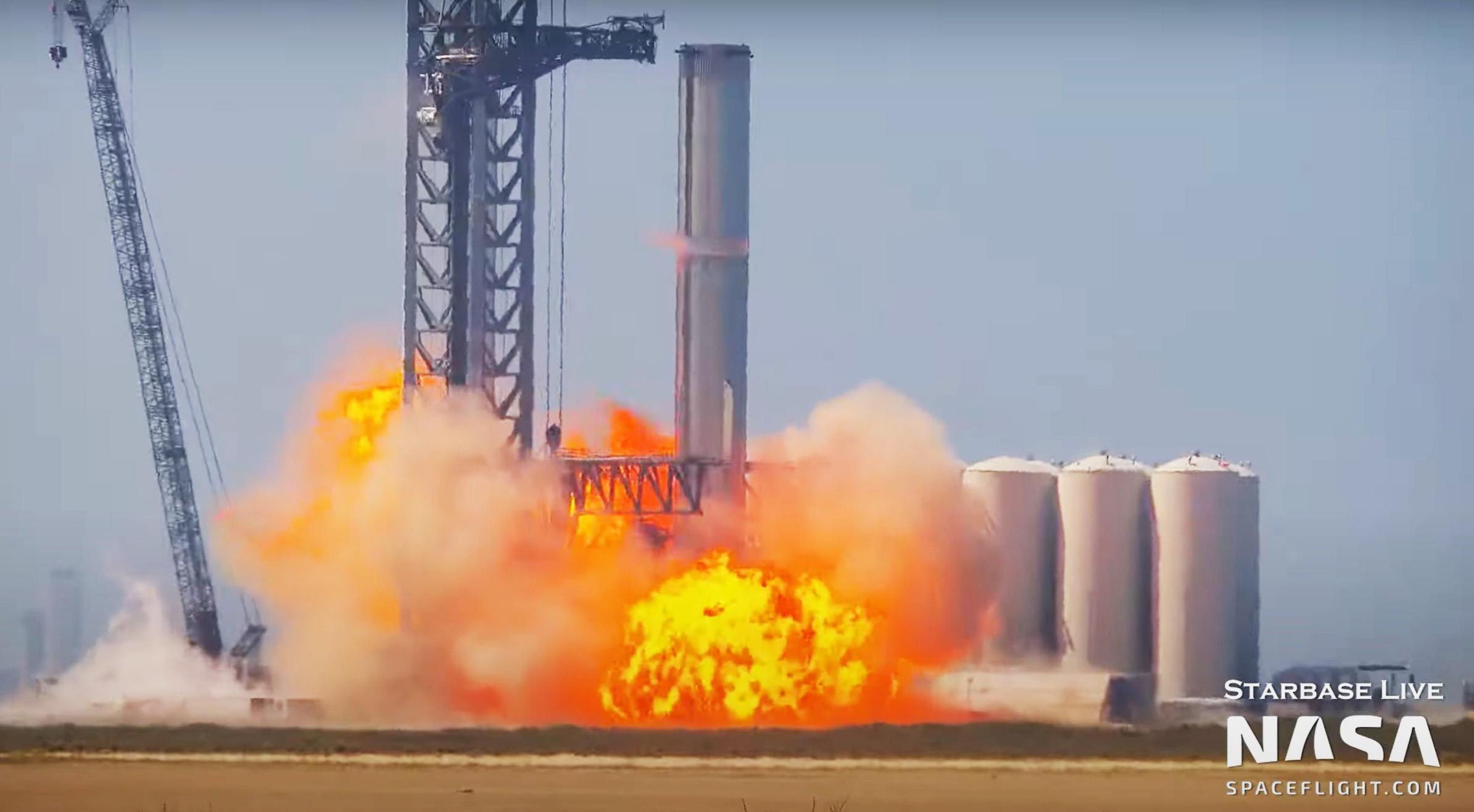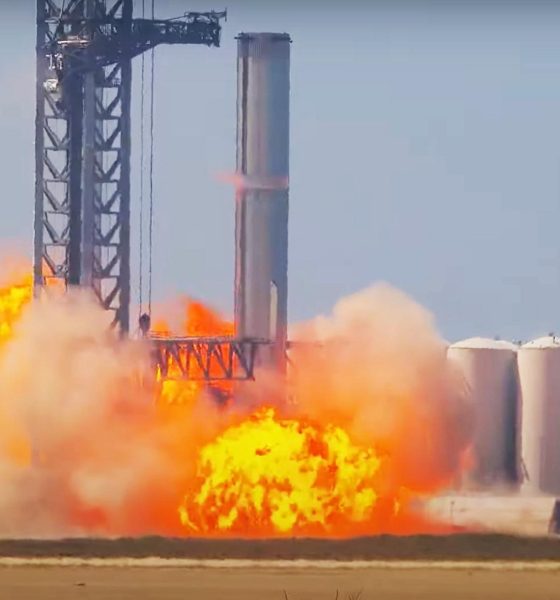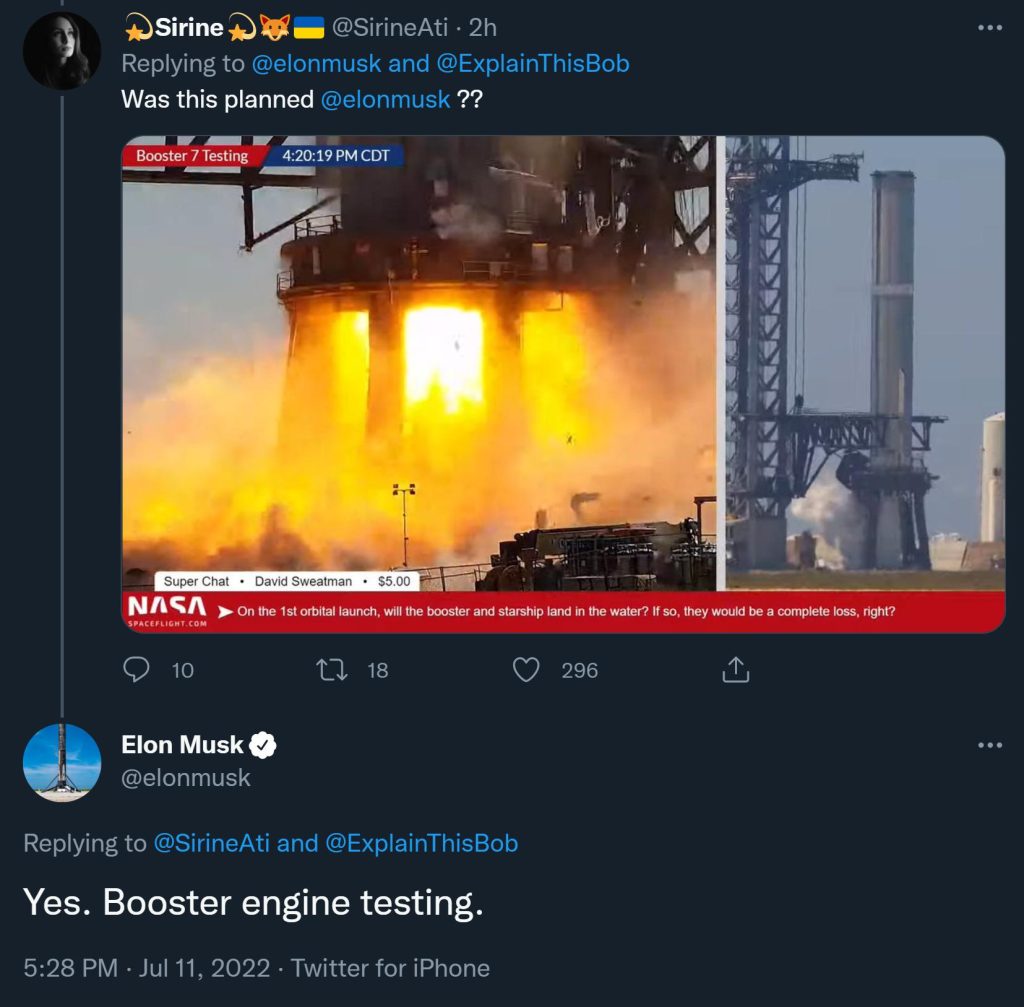

News
SpaceX Starship booster survives explosion
A SpaceX Super Heavy booster was rocked by a substantial explosion and subjected to multiple fires at the launch pad during the rocket’s latest round of testing.
As of 9 pm CDT, July 11th, the fate of the upgraded Super Heavy – known as Booster 7 or B7 – is leaning towards survival but and it won’t be certain until the rocket is drained of all cryogenic propellant and potentially flammable gas and safe for SpaceX employees to approach. The incident began around 4:20 pm CDT, when Super Heavy Booster 7 (or its launch mount) unintentionally ignited a cloud of flammable gas produced during flow test involving most or all of its 33 Raptor engines. In the past, SpaceX has performed “spin prime” tests with Raptors installed on Starship prototypes, flowing high-pressure gas through the engines’ turbines to get them up to operating speeds and pressures. Booster 7’s test ended a bit differently.
When the resulting cloud of well-mixed methane and oxygen gas was accidentally ignited, it functioned like a small fuel-air bomb, rapidly combusting to produce a violent explosion and shockwave. After the initial explosion, the fire also expanded to burn as much of the resulting gas as possible, producing a fireball that briefly reached 80-90 meters (~260-300 ft) in height. CEO Elon Musk – apparently not directly participating in the test – initially stated that the explosion and fire was planned, implying that it was more or less a nominal outcome. Virtually everyone with experience observing Starship testing felt otherwise, however.

To preserve the safety of the few local residents still living at Boca Chica Village, SpaceX is required to issue printed safety warnings well in advance of Starship tests that could create a shockwave capable of shattering glass and injuring locals. SpaceX has never intentionally performed such a test without distributing those warnings and did not distribute a warning before July 11th, all but guaranteeing that no ignition event was planned. A few hours later, Musk deleted his original tweet and posted a different one, confirming that the explosion was “actually not good” and that SpaceX is “assessing the damage.”
For the most part, Booster 7 and the Starbase Orbital Launch Site (OLS) exceeded viewers’ expectations of their sturdiness, exhibiting very little off-nominal behavior after being subjected to a unexpected explosion, shockwave, and fire. Immediately after the event, B7 quickly depressurized its propellant tanks and appeared to leave those vents open, reducing the chances of the booster destroying itself if SpaceX were to lose control. SpaceX also appeared to intentionally avoid using the orbital launch mount’s (OLM) umbilical mechanism to remove propellant from the Super Heavy’s tanks, perhaps concerned that the shockwave might have weakened its connection to B7.
About an hour after the explosion, Booster 7 dumped a large amount of cryogenic liquid out of a new vent located on its aft end, producing a flood that spread around the adjacent pad. It’s unclear if that liquid was nitrogen or oxygen but either way, the emergency propellant dump appeared to cause a fire to start about 100 feet (~30m) from the booster and launch mount. That fire proceeded to burn intermittently for the next two hours, all the while posing a clear and present danger to the rest of the pad and booster if it were to spread in the wrong direction or breach the wrong underground pipe. Instead, SpaceX got lucky and the fire eventually self-extinguished.
In a worst-case scenario, Super Heavy’s engine section and 33 Raptor engines could have been seriously damaged, while the subsequent pad fire(s) could have also significantly damaged crucial pad systems, requiring weeks of repairs. The booster could even be beyond repair. More optimistically, given that SpaceX appears to have gotten lucky enough to avoid a total loss of vehicle, Booster 7 may be fine after some inspections and moderate repairs. The pad damage could also be limited to a single isolated, non-critical piece of equipment catching fire and burning to a crisp
Regardless, SpaceX will need to figure out what exactly caused the explosion and make sure that that failure mode does not appear again. In the meantime, the company recently finished stacking Super Heavy Booster 8, and Starship S24 – installed on a nearby suborbital test stand – is ready to begin its own static fire test campaign in the near future.

Elon Musk
Tesla’s Elon Musk: 10 billion miles needed for safe Unsupervised FSD
As per the CEO, roughly 10 billion miles of training data are required due to reality’s “super long tail of complexity.”

Tesla CEO Elon Musk has provided an updated estimate for the training data needed to achieve truly safe unsupervised Full Self-Driving (FSD).
As per the CEO, roughly 10 billion miles of training data are required due to reality’s “super long tail of complexity.”
10 billion miles of training data
Musk comment came as a reply to Apple and Rivian alum Paul Beisel, who posted an analysis on X about the gap between tech demonstrations and real-world products. In his post, Beisel highlighted Tesla’s data-driven lead in autonomy, and he also argued that it would not be easy for rivals to become a legitimate competitor to FSD quickly.
“The notion that someone can ‘catch up’ to this problem primarily through simulation and limited on-road exposure strikes me as deeply naive. This is not a demo problem. It is a scale, data, and iteration problem— and Tesla is already far, far down that road while others are just getting started,” Beisel wrote.
Musk responded to Beisel’s post, stating that “Roughly 10 billion miles of training data is needed to achieve safe unsupervised self-driving. Reality has a super long tail of complexity.” This is quite interesting considering that in his Master Plan Part Deux, Elon Musk estimated that worldwide regulatory approval for autonomous driving would require around 6 billion miles.
FSD’s total training miles
As 2025 came to a close, Tesla community members observed that FSD was already nearing 7 billion miles driven, with over 2.5 billion miles being from inner city roads. The 7-billion-mile mark was passed just a few days later. This suggests that Tesla is likely the company today with the most training data for its autonomous driving program.
The difficulties of achieving autonomy were referenced by Elon Musk recently, when he commented on Nvidia’s Alpamayo program. As per Musk, “they will find that it’s easy to get to 99% and then super hard to solve the long tail of the distribution.” These sentiments were echoed by Tesla VP for AI software Ashok Elluswamy, who also noted on X that “the long tail is sooo long, that most people can’t grasp it.”
News
Tesla earns top honors at MotorTrend’s SDV Innovator Awards
MotorTrend’s SDV Awards were presented during CES 2026 in Las Vegas.

Tesla emerged as one of the most recognized automakers at MotorTrend’s 2026 Software-Defined Vehicle (SDV) Innovator Awards.
As could be seen in a press release from the publication, two key Tesla employees were honored for their work on AI, autonomy, and vehicle software. MotorTrend’s SDV Awards were presented during CES 2026 in Las Vegas.
Tesla leaders and engineers recognized
The fourth annual SDV Innovator Awards celebrate pioneers and experts who are pushing the automotive industry deeper into software-driven development. Among the most notable honorees for this year was Ashok Elluswamy, Tesla’s Vice President of AI Software, who received a Pioneer Award for his role in advancing artificial intelligence and autonomy across the company’s vehicle lineup.
Tesla also secured recognition in the Expert category, with Lawson Fulton, a staff Autopilot machine learning engineer, honored for his contributions to Tesla’s driver-assistance and autonomous systems.
Tesla’s software-first strategy
While automakers like General Motors, Ford, and Rivian also received recognition, Tesla’s multiple awards stood out given the company’s outsized role in popularizing software-defined vehicles over the past decade. From frequent OTA updates to its data-driven approach to autonomy, Tesla has consistently treated vehicles as evolving software platforms rather than static products.
This has made Tesla’s vehicles very unique in their respective sectors, as they are arguably the only cars that objectively get better over time. This is especially true for vehicles that are loaded with the company’s Full Self-Driving system, which are getting progressively more intelligent and autonomous over time. The majority of Tesla’s updates to its vehicles are free as well, which is very much appreciated by customers worldwide.
Elon Musk
Judge clears path for Elon Musk’s OpenAI lawsuit to go before a jury
The decision maintains Musk’s claims that OpenAI’s shift toward a for-profit structure violated early assurances made to him as a co-founder.

A U.S. judge has ruled that Elon Musk’s lawsuit accusing OpenAI of abandoning its founding nonprofit mission can proceed to a jury trial.
The decision maintains Musk’s claims that OpenAI’s shift toward a for-profit structure violated early assurances made to him as a co-founder. These claims are directly opposed by OpenAI.
Judge says disputed facts warrant a trial
At a hearing in Oakland, U.S. District Judge Yvonne Gonzalez Rogers stated that there was “plenty of evidence” suggesting that OpenAI leaders had promised that the organization’s original nonprofit structure would be maintained. She ruled that those disputed facts should be evaluated by a jury at a trial in March rather than decided by the court at this stage, as noted in a Reuters report.
Musk helped co-found OpenAI in 2015 but left the organization in 2018. In his lawsuit, he argued that he contributed roughly $38 million, or about 60% of OpenAI’s early funding, based on assurances that the company would remain a nonprofit dedicated to the public benefit. He is seeking unspecified monetary damages tied to what he describes as “ill-gotten gains.”
OpenAI, however, has repeatedly rejected Musk’s allegations. The company has stated that Musk’s claims were baseless and part of a pattern of harassment.
Rivalries and Microsoft ties
The case unfolds against the backdrop of intensifying competition in generative artificial intelligence. Musk now runs xAI, whose Grok chatbot competes directly with OpenAI’s flagship ChatGPT. OpenAI has argued that Musk is a frustrated commercial rival who is simply attempting to slow down a market leader.
The lawsuit also names Microsoft as a defendant, citing its multibillion-dollar partnerships with OpenAI. Microsoft has urged the court to dismiss the claims against it, arguing there is no evidence it aided or abetted any alleged misconduct. Lawyers for OpenAI have also pushed for the case to be thrown out, claiming that Musk failed to show sufficient factual basis for claims such as fraud and breach of contract.
Judge Gonzalez Rogers, however, declined to end the case at this stage, noting that a jury would also need to consider whether Musk filed the lawsuit within the applicable statute of limitations. Still, the dispute between Elon Musk and OpenAI is now headed for a high-profile jury trial in the coming months.








